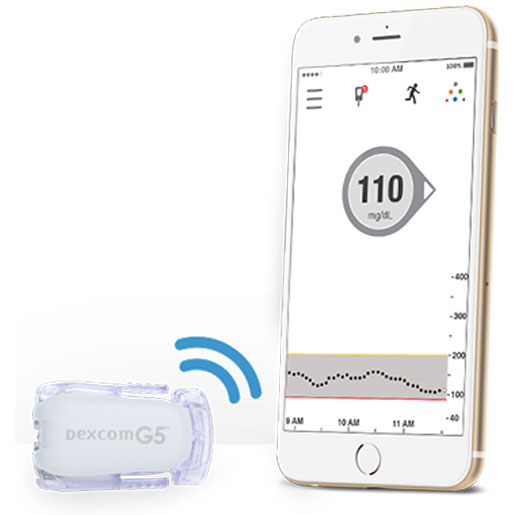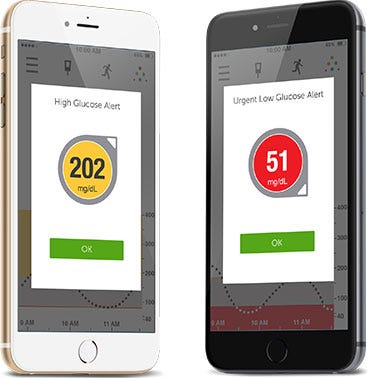Continuous glucose monitors are evolving to better service people with diabetes, but those without diabetes could also benefit from CGM technology. What's needed to make CGM accessible to a wider patient population?
September 3, 2015

Continuous glucose monitors are evolving to better service people with diabetes, but those without diabetes could also benefit from CGM technology. What's needed to make CGM accessible to a wider patient population?
Samantha Katz
Dexcom's G5 CGM transmitter and a smartphone are tools that can be used to monitor blood glucose levels.
The recipe for a successful health wearable is still in the works. Many have gotten step one right (acquire lots of users) but step two (retain lots of users) has yet to be perfected. In fact, Rock Health, a leading digital health investment fund and accelerator, dug through Fitbit's recent IPO filing to estimate that more than 70% of purchasers churn in less than 12 months.
Continuous glucose monitors (CGM) also face attrition issues. Currently marketed to people with diabetes, CGM consists of a small subcutaneous sensor that measures glucose in interstitial fluid and wirelessly sends a measurement to a display device every five minutes. The system contains alerts and alarms that let users know when glucose has gone too high or too low in real time. Additionally, users can review their CGM data retrospectively through manufacturers' therapy management software programs, or together with data from their insulin pump, if they use one. Though the technology can save lives, CGM presents a number of usability challenges that serve as barriers to widespread adoption and retention.
Fortunately, CGM manufacturers are increasingly focusing on improving usability. Dexcom, a leading CGM company, recently announced that it is collaborating with the life sciences team at Google to develop a CGM that is smaller and less expensive than current technologies on the market for people with diabetes. At first, I was excited to hear that two highly innovative companies are working together on CGM and addressing key challenges of the current technology. Many more people with diabetes are sure to sign on for a smaller and more affordable CGM.
But what about people without diabetes who want to manage weight, prevent pre-diabetes and heart disease, and combat infertility? While size and cost are significant barriers to CGM usage, they are only two of CGM's many pain points that limit more widespread adoption and retention. In order to truly impact CGM adoption and retention among people without diabetes, device manufacturers must focus on these additional user needs:
|
Katz |
Accuracy Without Burden
Even for people without diabetes, accuracy is crucial for CGM to be useful; without it, alerts and alarms are irrelevant and irritating, and the data is not revealing. The most accurate sensor commercially available is Dexcom's recently approved G5, whose accuracy is in line with many blood glucose (BG) meters on the market. However, the G5's accuracy measurement was obtained in a clinical study where subjects followed a strict protocol to calibrate their sensor approximately once every 12 hours using a correctly executed fingerstick BG measurement.
In the real world, users don't always calibrate this frequently or on schedule, largely because taking a fingerstick measurement is painful and inconvenient. In addition, users don't always perform a fingerstick correctly; for example, sometimes they don't wash their hands prior to taking a measurement for any number of reasons. While CGM accuracy has been improving steadily over the past several years, the user burden required to obtain it has not changed and will need to decrease to attract a wider user base.
The On-Body Experience
While we may see long-wear implantable CGM sensors in the future (which will surely come with their own set of user challenges), the sensors on the market today are worn for about a week and consist of a small sensor probe that is inserted subcutaneously and an attached transmitter that is affixed on top of the skin with an adhesive patch. Ideally, sensor insertion would be painless and bloodless, the transmitter would be comfortable and discreet to wear, and the adhesive would maintain its hold for the duration of the sensor's life and not irritate the skin.
|
The Dexcom G5 Mobile CGM System gives users high and low glucose alerts on their smartphones. |
Not so in reality. The sensor is inserted with a needle. We move, we bang into things, we sweat, we shower and swim, and we want to wear form-fitting clothing, which reveals the transmitter. Dexcom and Google are on the right path with their plans for a smaller device, but size is only one part of the on-body experience. Manufacturers must also consider flexibility in where the user can wear the sensor, the shape, aesthetics, and contours of the transmitter, and adhesive optimization. Additionally, subcutaneous sensor insertion remains a barrier to widespread adoption. While a few companies are working on painless, non-invasive CGM technologies, many more have come and gone over the years, so it remains to be seen if it is feasible.
Effortless Instruction
CGM for people without diabetes is no different than other wearables. Data is nice, but insights are better. Even with perfectly accurate sensor data and an ideal on-body experience, if users don't know what their glucose data means or what they should do about it, they won't benefit from CGM, and the device is likely to end up in the junk drawer graveyard.
For example, Google recently announced a collaboration with insulin manufacturer Sanofi to develop a system for people with diabetes involving insulin delivery and glucose management "that helps physicians and patients see how they're doing." This description raises a red flag. Rather than provide data for users to "see," CGM must empower users with insights they can act on to make meaningful health changes.
In addition, to truly ensure widespread CGM retention, the challenge is even greater. Users don't want to have to make any effort to get these actionable insights. Medtronic Diabetes, another CGM manufacturer, recognized this, recently announcing a partnership with IBM to utilize super-computer Watson's HealthCloud to develop near real-time personalized diabetes management and decision support solutions. While details from the companies are vague thus far, the personalization aspect insinuates that the solutions will provide relevant and timely instruction rather than just data or even insights. Devices that explicitly tell users how they are doing and what they should do in the moment will have the greatest adherence.
The recipe for CGM adoption and retention, especially for people without diabetes, is a mixture of technology and user empathy, and both must be present to get it right. By focusing on accuracy without burden, the on-body experience, and effortless instruction, device manufacturers will be able to overcome the largest barriers to widespread CGM use.
Learn about trends in medical design innovation at the MD&M Philadelphia conference, October 7-8, 2015. |
Samantha Katz is the digital health lead and a senior strategist at Continuum, a global innovation design consultancy. Continuum partners with clients to discover powerful ideas and realize them as products, services, and brand experiences that improve lives and grow businesses. Sam previously held marketing and product development roles focused on insulin pumps and CGM systems at Medtronic Diabetes.
[Images courtesy of DEXCOM, INC. and CONTINUUM]
You May Also Like
.jpg?width=700&auto=webp&quality=80&disable=upscale)



